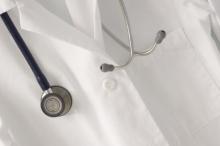Some people wear their hearts on their sleeves. Doctors and nurses wear a lot more there, it seems.
Sixty percent of doctors’ hospital uniforms and 65% of nurses’ uniforms tested contained potentially pathogenic bacteria in at least one place, according to research published this month in the American Journal of Infection Control.
It’s not clear whether these bacteria pose an infection risk, but the authors of a study on pathogens recommended that physicians and nurses wear clean uniforms daily, improve hand hygiene practices, and use plastic aprons when performing tasks that may involve splashing or contact with body fluids.
"Wearing short-sleeved coats or even having physicians discard their white coats could further reduce the cloth-borne transmission of pathogens," reported researchers led by Dr. Yonit Wiener-Well of Shaare Zedek Medical Center, Jerusalem.
They collected swab samples from three parts of the uniforms of 75 registered nurses and 60 physicians by pressing standard blood agar plates to the uniforms’ abdominal areas, sleeve ends, and pockets (Am. J. Infect. Control 2011;39:555-9).
All the uniforms tested contained nonpathogenic common skin bacteria, and half of the samples included some sort of pathogen in addition to the nonpathogenic bacteria, the researchers noted. Of the 238 total samples taken from uniforms, 14% from nurses’ gowns and 6% from physicians’ gowns contained multidrug resistant bacteria, including methicillin-resistant Staphylococcus aureus (MRSA), the study found.
"It remains to be determined whether these bacteria can be transferred to patients and cause clinically relevant infection," the authors wrote. "The high prevalence of contaminated uniforms might be related to inadequate compliance with hand hygiene, given that the sampled sites (i.e., abdominal zone, sleeve ends, and pockets on the dominant side) are characterized by frequent hand touches."
There were no significant differences in the number of positive samples between staff from medical departments and surgical departments, the study said.
The researchers also tested four uniforms immediately after they had been cleaned by the hospital laundry, and found only common skin bacteria on those uniforms. "Bacterial loads were significantly lower than on the uniforms being worn," the investigators said.
Fifty-eight percent of those who participated in the study said they changed their uniform every day, and 77% said their attire reached a "fair to excellent" level of hygiene.


